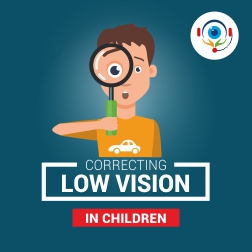Pediatric Low Vision
Disease
When a partial vision loss cannot be treated, it results in Low Vision. An individual with this vision impairment normally experiences a decrease in vision or peripheral vision, or both.
Causes
Pediatric low vision can result from a number of factors which include -
1. Pediatric Glaucoma
2. Albinism
3. Pediatric Cataracts
4. Nystagmus
5. Optic Nerve and Retinal Abnormalities
A child with low vision will experience a difficulty in reading, seeing potentially hazardous objects (steps, walls etc.) or recognizing a familiar face. Printed material may appear distorted for a child who may have low vision.
If you notice the above signs in your child, you must get your child's eyes diagnosed by a pediatric ophthalmologist.
Diagnosis
During diagnosis of pediatric low vision, your child's ophthalmologist will conduct an eye examination. Pediatric low vision assessment will differ depending on the child's age. During diagnosis, the ophthalmologist will try and procure as much information about your child's vision by conducting the following tests -
1. Visual Acuity - This test will help determine how small an object your child can see.
2. Visual Field - The extent of peripheral or side vision will be tested in this.
3. Colour Vision
4. Refractive Error - This test will help determine the type of prescription eyeglass that will be required to aid in improving your child's vision.
5. Eye Muscle Function - The alignment of the eyes and the eye's ability to move in every direction will be tested.
In addition to these tests, Electroretinogram (ERG) and Visual Evoked Potential (VEP) testing may also be recommended by the pediatric ophthalmologist.
Treatment
Early Intervention is recommended for children who have low vision and are under the age of three. A team of special education professionals are part of the Early Intervention. They work with parents to create a family-centered program to help children develop and strengthen their abilities.
Normally, a teacher who works with visually impaired children will be part of the child's Early Intervention. Along with this, your child would need physical, occupational and speech therapy.
Children who are in school and have low vision are normally taken care of by a teacher of the visually impaired.
Apart from these, the following may be recommended as treatment options -
1. Glasses and/or Contact Lenses
2. Binoculars
3. Telescopes/Tinted Lenses
4. Magnifiers
5. Closed Circuit TVs
6. Large Print Books
7. Adaptive Technology
Takeaway
Low vision does not make one blind, and someone who has low vision will be able to retain some of their useful vision. Also with regard to low vision, there is no cure. Treatment will only help the child live their day-to-day lives.



